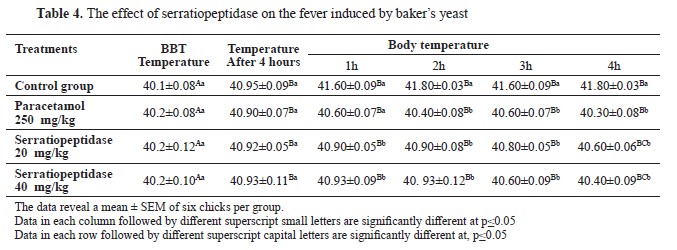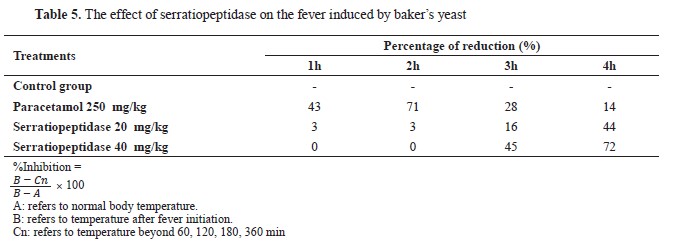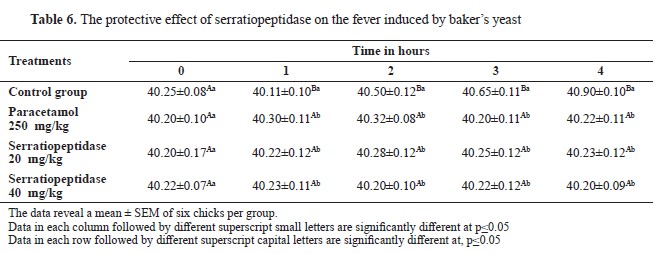5. Robert, R. (2006). The ‘Miracle’ enzymeTM is serrapeptase, the 2nd gift from Silkworms. Naturally Healthy Publications
6. Carratu, L., Marangio, E., Cuomo, A., Pesci, A., Sofia, M., Barani, G. (1980). Physico-chemical and rheological research on mucolytic activity of serratiopeptidase in chronic broncho pneumopathies. Curr Ther Res. 28, 937-951.
9. Joshi, K.K., Nerurkar, RP. (2012). Anti-inflammatory effect of the serratiopeptidase--rationale or fashionable: a study in rat paw oedema model induced by the carrageenan. Indian J Physiol Pharmacol. 56(4): 367-374.
10. Chappi D., M, Suresh, K.V., Patil, M.R., Desai, R., Tauro, D.P., K.N.S. S.B., Parkar, M.I., Babaji, H.V. (2015). Comparison of clinical efficacy of methylprednisolone and serratiopeptidase for reduction of postoperative sequelae after lower third molar surgery. J Clin Exp Dent. 7(2): e197-e202.
https://doi.org/10.4317/jced.51868 PMid:26155332 PMCid:PMC4483323
11. Jadav, S.P., Patel, N.H., Shah, T.G., Gajera, M.V., Trivedi, H.R., Shah, B.K. (2010). Comparison of antiinflammatory activity of serratiopeptidase and diclofenac in albino rats. J Pharmacol Pharmacother. 1(2): 116-117.
https://doi.org/10.4103/0976-500X.72362 PMid:21350623 PMCid:PMC3043339
12. Mecikoglu, M., Saygi, B., Yildirim, Y., Karadag-Saygi, E., Ramadan, S.S., Esemenli, T. (2006). The effect of proteolytic enzyme serratiopeptidase in the treatment of experimental implant related infection. J Bone Joint Surg Am. 88(6): 1208-1214.
https://doi.org/10.2106/JBJS.E.00007 PMid:16757752
13. Buckley, C.D., Gilroy, D.W., Serhan, C.N., Stockinger, B., Tak, P.P. (2013). The resolution of inflammation. Nat Rev Immunol. 13(1): 59-66.
https://doi.org/10.1038/nri3362 PMid:23197111
14. Hosseinzadeh, S.A., Valizadeh, V., Rouhani, M., Mirkazemi, S., Azizi, M., Norouzian, D. (2022). Novel serratiopeptidase exhibits different affinities to the substrates and inhibitors. Chem Biol Drug Des. 100(4): 553-563.
https://doi.org/10.1111/cbdd.14105 PMid:35729860
15. Paul-Murphy, J.R., Brunson, D.B., Miletic, V. (1999). Analgesic effects of butorphanol and buprenorphine in conscious African grey parrots (Psittacus erithacus erithacus and Psittacus erithacus timneh). Am J Vet Res. 60(10): 1218-1221.
https://doi.org/10.2460/ajvr.1999.60.10.1218 PMid:10791933
16. Evrard, H.C., Balthazart, J. (2002). The assessment of nociceptive and non-nociceptive skin sensitivity in the Japanese quail (Coturnix japonica). J Neurosci Methods. 116(2): 135-146.
https://doi.org/10.1016/S0165-0270(02)00034-1 PMid:12044663
17. Naser, A., Albadrany, Y., Shaaban, KA. (2021). Methods of pain assessment in chicks as a model. Egypt J Vet Sci. 52(2): 241-249.
https://doi.org/10.21608/ejvs.2021.64605.1219 18. Naser, A.S., Albadrany, Y., Shaaban, K.A. (2020). Isobolographic analysis of analgesic interactions of silymarin with ketamine in mice. J Hell Vet Med Soc. 71(2): 2171-2178.
https://doi.org/10.12681/jhvms.23653 19. Alberifki, N.M., Naser, A.S. (2023). Flurbiprofen: determination of safety profile, analgesic effect, and interaction with lipoic acid in murine. Iraqi J Vet Sci. 37(2): 447-452.
https://doi.org/10.33899/ijvs.2023.136615.2599 20. Hughes, R.A., Sufka, K.J. (1991). Morphine hyperalgesic effects on the formalin test in domestic fowl (Gallus gallus). Pharmacol Biochem Behav. 38(2): 247-251.
https://doi.org/10.1016/0091-3057(91)90273-5 PMid:2057496
21. Abdul-Ghani, M.R., Naser, A.S. (2022). Bakers’ yeast induced paw edema and fever in chicks for detection of anti-inflammatory effects of alphalipoic acid: a new approach. Egypt J Vet Sci. 53(2): 185-191.
https://doi.org/10.21608/ejvs.2022.107080.1314 22. Henry, D.A. (1988). Side-effects of non-steroidal anti-inflammatory drugs. Baillieres Clin Rheumatol. 2(2): 425-454.
https://doi.org/10.1016/S0950-3579(88)80021-9 PMid:3066501
23.El-Ghany, W. (2023). A natural feed additive phytobiotic, pomegranate (Punica granatum L.), and the health status of poultry. Mac Vet Rev. 46(2): 113-128.
https://doi.org/10.2478/macvetrev-2023-0022 24. Yadav, V., Sharma, S., Kumar, A., Singh, S., Ravichandiran, V. (2023). Serratiopeptidase attenuates lipopolysaccharide-induced vascular inflammation by inhibiting the expression of monocyte chemoattractant protein-1. Curr Issues Mol Biol. 45(3): 2201-2212.
https://doi.org/10.3390/cimb45030142 PMid:36975512 PMCid:PMC10047379
25. Mammdoh, J.K., Al-Alsadoon, L.H., Taqa, G.A., Taqa, A.A. (2022). Evaluation of anti-inflammatory effect of topical serratiopeptidase in mice. Inflammation. 12(1): 162-166.
26. Nirale, N.M., Menon, M.D. (2010). Topical formulations of serratiopeptidase: development and pharmacodynamic evaluation. Indian J Pharm Sci. 72(1): 65-71.
https://doi.org/10.4103/0250-474X.62246 PMid:20582192 PMCid:PMC2883229
27. Moriya, N., Shoichi, A., Yoko, H., Fumio, H., Yoshiaki, K. (2003). Intestinal absorption of serrapeptase and its distribution to the inflammation sites. Japanese Pharmacol Ther. 31(8): 659 666.
28. Woodley, J.F. (1994). Enzymatic barriers for GI peptide and protein delivery. Crit Rev Ther Drug Carrier Syst. 11(2-3): 61-95.
29. Moriya, N., Nakata, M., Nakamura, M., Takaoka, M., Iwasa, S, Kato, K. (1994). Intestinal absorption of serrapeptase (TSP) in rats. Biotechnol Appl Biochem. 20(1): 101-108.
https://doi.org/10.1111/j.1470-8744.1994.tb00308.x PMid:7917060
30. Parada, C.A., Tambeli, C.H., Cunha, F. de Q., Ferreira, S.H. (2001). The major role of peripheral release of histamine and 5-hydroxytryptamine in formalin-induced nociception. Neuroscience. 102(4): 937-944.
https://doi.org/10.1016/S0306-4522(00)00523-6 PMid:11182255
31. Singh, B.M., Negi, G., Bhole, P., Jaiprakash, M. (2012). Pain and inflammation: a review. Int J Pharm Sci Res. 3(12): 4697-4709.
32. Nair, S.R. (2022). Serratiopeptidase: an integrated view of multifaceted therapeutic enzyme. Biomolecules 12(10): 1468.
https://doi.org/10.3390/biom12101468 PMid:36291677 PMCid:PMC9599151
33. Jadhav, S.B., Shah, N., Rathi, A., Rathi, V., Rathi, A. (2020). Serratiopeptidase: insights into the therapeutic applications. Biotechnol Rep (Amst). 28: e00544.
https://doi.org/10.1016/j.btre.2020.e00544 PMid:33134103 PMCid:PMC7585045
34. El-Radhi, A.S. (2018). Fever in common infectious diseases. Clin Man Fever Child. 85-140.
https://doi.org/10.1007/978-3-319-92336-9_5 PMCid:PMC7122655
35. Ivanov, A.I., Romanovsky, A.A. (2004). Prostaglandin E2 as a mediator of fever: synthesis and catabolism. Front Biosci. 9, 1977-1993.
https://doi.org/10.2741/1383 PMid:14977603
36. Bhagat, S., Agarwal, M., Roy, V. (2013). Serratiopeptidase: a systematic review of the existing evidence. Int J Surg. 11(3): 209-217.
https://doi.org/10.1016/j.ijsu.2013.01.010 PMid:23380245
37. Vaday, G.G., Lider, O. (2000). Extracellular matrix moieties, cytokines, and enzymes: dynamic effects on immune cell behavior and inflammation. J Leukoc Biol. 67(2): 149-159.
https://doi.org/10.1002/jlb.67.2.149 PMid:10670574
38. Birkedal‐Hansen, H. (1993). Role of cytokines and inflammatory mediators in tissue destruction. J Periodontal Res. 28(6 Pt 2): 500-510.
https://doi.org/10.1111/j.1600-0765.1993.tb02113.x PMid:8263720
39. Tiwari, M. (2017). The role of serratiopeptidase in the resolution of inflammation. Asian J Pharm Sci. 12(3): 209-215.
https://doi.org/10.1016/j.ajps.2017.01.003 PMid:32104332 PMCid:PMC7032259

 10.2478/macvetrev-2024-0021
10.2478/macvetrev-2024-0021







